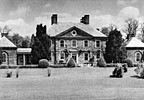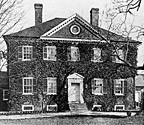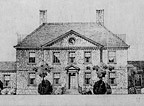Mott Schmidt Biography
- Featured Architecture:
- ABOUT MOTT SCHMIDT
- Introduction
- Beginnings and Sutton Place
- Townhouses and Apartments
- Country Houses
- Late Works
- Townhouses
- Sutton Place
- Anne Morgan Townhouse
- Mrs W.K. Vanderbilt Townhouse
- Guy Fairfax Cary Townhouse
- Miss Emily Trevor Townhouse
- Vincent Astor Townhouse
- Walter E. Hope Townhouse
- Apartment Houses
- 53 East 66th Street
- 1088 Park Avenue
- 19 East 72nd Street
- Country Houses
- Mr & Mrs Clarence Dillon Summer House
- Pook's Hill: Mr & Mrs Mott B. Schmidt Country House
- Marienruh: Mrs Serge Obolensky Country House
- Mr & Mrs Bernard Peyton Country House
- C. Douglas Dillon Country House
- Hudson Pines: Mrs David M. Milton Abby Rockefeller Country House
- Hillcrest: Mrs Martha Baird Rockefeller Country House
- Municipal Buildings
- Municipal Building and Post Office, Mount Kisco
- Susan B. Wagner Wing, Gracie Mansion
- Other Buildings
- French City Village Houses
- Selected Commissions for the Rockefeller Family
by Mark Alan Hewitt
- The Country House
- The Colonial Tradition
- Dillon and Obolensky Houses
- Pook's Hill
- 1930s Commissions
- Well-planned Graciousness
In 1923 Schmidt
repeated the clapboard idiom for banker and former townhouse client Clarence
Dillon. In this sprawling summer house in Dark Harbor, Maine, he masterfully
assembled a series of cottage-like elements in an offset, interlocking block
along the shore of the island (Figure 26). Since he was building in
an established summer colony, near the clapboard, Colonial-Revival Isleboro Inn
(Edmund Evans, 1917), Schmidt might have felt compelled to use the local
vernacular. And, as he was building a rather large house, keeping to the
modest New England cottage idiom was hardly easy. Yet the shingled Dillon house
achieved the informality and seaside spirit of a summer cottage while
fulfilling the needs of a large household. It is Schmidt's most successful
rustic house and can be compared with the nearby Antoine Devereux house (1917)
by Mellor, Meigs and Howe (Figure 27). The Philadelphia firm treated this
clapboard house in a manner indebted to the English Arts & Crafts - much
like one of their stone houses on the Main Line. Schmidt was far more faithful
to the nuances of the Maine vernacular, if one discounts the odd stair tower
on the north side.
Schmidt seemed to hit his stride in country house work by the mid 1920s.
His first masterly design was the Serge Obolensky house, called Marienruh
(Figure 28); executed for Vincent Astor's sister on his estate in Rhinebeck, New
York. For the first time he turned directly to grand 18th
century American country houses for inspiration, basing his design primarily
on the Matthias Hammond House (1770) by William Buckland in Annapolis, and
Montpelier (1751) (Figure 29) in Prince George County, Maryland.
The plan of the Obolensky house was a pragmatic adaptation of the model whose
"double pile" diagram was compromised for reasons of comfortable
circulation and room placement. Schmidt was never adverse to distorting the
symmetry within a block to accommodate a stair, powder room or pantry. Unlike
his Beaux-Arts-trained predecessors, he placed convenience before formal
issues. Still, the Obolensky house has the aura of a great colonial house. Its
proportions recall those of the Hammond house, as do the pedimented facades of
the center block and the dependencies on the garden side, which are rectangular
rather than octagonal (which Schmidt did try in an earlier scheme). The
Obolensky house is executed in random ashlar stone rather than brick, and thus
acquires a different surface character with different demands in articulation.
Schmidt's cornices and door surrounds are more robust than Buckland's, as they
must be to complement the rougher surface of the stone. His soft pencil
renderings capture the effects of light falling on these variegated surfaces
(Figure 30).




